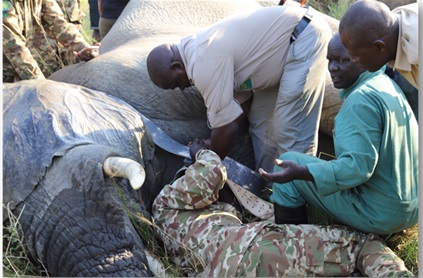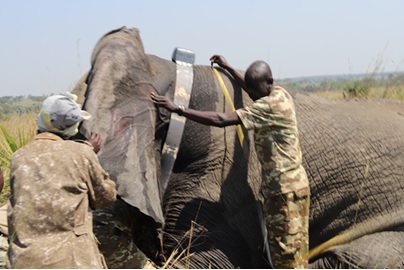Wildlife Conservation Society (WCS) in partnership with Uganda Wildlife Authority, and Total E&P Uganda (TEPU) has collared fifteen (15) elephants in Murchison Falls National Park (MFNP) in order to assess and mitigate the negative development impact on wildlife species.
Data collected during the monitoring of the collared elephants will guide TEPU to assess and design effective mitigation measures associated with the implementation of Tilenga Oil and Gas Development Project. Elephants live in social groups of 4-20 individuals led by a matriarch. These groups are built on complex networks of social bonds that change in strength and quality over time, depending on both the relationships amongst the elephants and availability of resources such as food and water. Elephants play vital roles of maintaining suitable habitats for many other species in savanna and forest ecosystems since they influence vegetation change through seed dispersal, canopy opening that encourages grass growth and tree regeneration.
The satellite collars were fitted onto individual elephants identified from the varied herds in the Northern Bank (north of River Nile) of MFNP. Ten (10) of the units were placed on individuals previously collared in 2016 to ensure continuity of data generation, and five on new individuals located in the priority areas inside the park.
 When selecting individuals to collar, the team looks out for individuals that will generate useful spatial data such as elephants whose range is at the boundary of the park, in areas of conflict or areas outside conservancies or protected areas. They also look for candidates that represent crop-raiding elephants and candidates that represent large herds that are highly mobile. A collared elephant, therefore, represents a herd that may be at risk.
When selecting individuals to collar, the team looks out for individuals that will generate useful spatial data such as elephants whose range is at the boundary of the park, in areas of conflict or areas outside conservancies or protected areas. They also look for candidates that represent crop-raiding elephants and candidates that represent large herds that are highly mobile. A collared elephant, therefore, represents a herd that may be at risk.
“We will be able to know how the oil and gas development, ongoing road construction and other future developments impact elephants and other wildlife in this park and, therefore, develop successful conservation strategies that deliver tourism and other ecosystem benefits. So we are grateful to TEPU sponsoring the long term research the MFNP” said Dr. Simon T Nampindo, the Country Director, Wildlife Conservation Society, Uganda Program.
Collars are a proven effective tool for generating information for protecting this threatened species with a rapidly dwindling population. The technology is a GPS tracking equipment that provides instantaneous data about the location of an animal within seconds of it being fitted onto an animal tracking collar. The Data is transmitted via satellite or the local cell phone network at an hourly interval and the collar lasts between 18-36 months.
The collar has in it a set of sophisticated, and specific, software algorithms with an alarm for immobility, a possible indicator that an elephant is in trouble, geo-fence breaches and streaks that enable wildlife management and enforcement to dispatch the rapid response unit in a timely fashion. The patrol team relies on the data transmitted by the satellite collar for their daily patrol planning.
From this technology, the team is also able to monitor the elephant’s behavior, diet, herd composition, age structure and habitat preference, and from its fecal cortisol, our researchers are able to assess the elephant’s stress levels especially now that there is ongoing road construction in Murchison Falls National Park and other activities that are likely to stress the species.
 In addition, using the collected data, the team is able to detect when elephants are headed towards human settlements or gardens and as such send the coordinates to the field officers, which helps prevent and reduce the risk of human-elephant conflict (HEC), a common phenomenon around the park. With this equipment, an estimation of the extent to which each elephant has been crop-raiding and how they distribute their time across the landscape, both inside and outside of protected areas can be made. In this way, field officers can identify hotspots, define critical habitat and corridors for the species in order to build a case for important areas for elephants and wildlife in the future.
In addition, using the collected data, the team is able to detect when elephants are headed towards human settlements or gardens and as such send the coordinates to the field officers, which helps prevent and reduce the risk of human-elephant conflict (HEC), a common phenomenon around the park. With this equipment, an estimation of the extent to which each elephant has been crop-raiding and how they distribute their time across the landscape, both inside and outside of protected areas can be made. In this way, field officers can identify hotspots, define critical habitat and corridors for the species in order to build a case for important areas for elephants and wildlife in the future. 
Joshua Mabonga, the WCS Carnivore Research Officer in Murchison Falls National Park and Queen Elizabeth National Park says, “Ranging behavior is key for conserving habitats and the corridors that link areas used by both elephants and other wildlife. Now that the human population in Uganda is growing at a very fast rate, making these decisions is critical.”
Collaring, monitoring and collecting data on elephants are key components for ensuring we meet our mission and objectives. WCS maintains a collaring schedule and this time, the monitoring will be for the next two years. WCS, Uganda Program has been monitoring the impacts of oil activities on elephants since 2008; and since 2013, it was with funding from Total E&P Uganda (TEPU).
African elephants face countless threats. In 2012 alone, 35,000 elephants were butchered for their tusks in Africa: that is 96 elephants killed each day. The Elephant range in Uganda has greatly reduced since the 60s with current distribution restricted to protected areas. The elephant population in Uganda is estimated at 5,739[1]. Among the threats are, habitat loss that is driven by Uganda’s rapid human population growth and the demand for agricultural land. The issuance of licenses by the government of Uganda to oil and gas companies to explore for oil in some protected areas could influence the elephant’s behavior and movement and therefore increase their exposure to the risk of poaching. Weak law enforcement also compounds these threats to elephant survival.